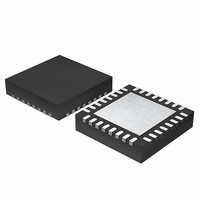EFM32G200F64 Energy Micro, EFM32G200F64 Datasheet - Page 413

EFM32G200F64
Manufacturer Part Number
EFM32G200F64
Description
MCU 32BIT 64KB FLASH 32-QFN
Manufacturer
Energy Micro
Series
Geckor
Datasheets
1.EFM32G200F16.pdf
(63 pages)
2.EFM32G200F16.pdf
(10 pages)
3.EFM32G200F16.pdf
(463 pages)
4.EFM32G200F16.pdf
(136 pages)
Specifications of EFM32G200F64
Core Processor
ARM® Cortex-M3™
Core Size
32-Bit
Speed
32MHz
Connectivity
EBI/EMI, I²C, IrDA, SmartCard, SPI, UART/USART
Peripherals
Brown-out Detect/Reset, DMA, POR, PWM, WDT
Number Of I /o
24
Program Memory Size
64KB (64K x 8)
Program Memory Type
FLASH
Ram Size
16K x 8
Voltage - Supply (vcc/vdd)
1.8 V ~ 3.8 V
Data Converters
A/D 4x12b, D/A 1x12b
Oscillator Type
External
Operating Temperature
-40°C ~ 85°C
Package / Case
32-VQFN Exposed Pad
Processor Series
EFM32G200
Core
ARM Cortex-M3
Data Bus Width
32 bit
Data Ram Size
16 KB
Interface Type
I2C, UART
Maximum Clock Frequency
32 MHz
Number Of Programmable I/os
24
Number Of Timers
2
Operating Supply Voltage
1.8 V to 3.8 V
Maximum Operating Temperature
+ 85 C
Mounting Style
SMD/SMT
Minimum Operating Temperature
- 40 C
Lead Free Status / RoHS Status
Lead free / RoHS Compliant
Eeprom Size
-
Lead Free Status / Rohs Status
Details
Available stocks
Company
Part Number
Manufacturer
Quantity
Price
- EFM32G200F16 PDF datasheet
- EFM32G200F16 PDF datasheet #2
- EFM32G200F16 PDF datasheet #3
- EFM32G200F16 PDF datasheet #4
- Current page: 413 of 463
- Download datasheet (8Mb)
2010-09-06 - d0001_Rev1.00
Note
The MUX setting determines the number of LCD COM lines that are enabled. When static multiplexing
is selected, LCD output is enabled on LCD_COM0, when duplex multiplexing is used, LCD_COM0-
LCD_COM1 are used, when triplex multiplexing is selected, LCD_COM0-LCD_COM2 are used, and
finally when quadruplex multiplexing is selected, all COM lines are driven by the LCD driver.
See Section 29.3.3 (p. 414) for waveforms for the different bias and multiplexing settings.
The waveforms generated by the LCD controller can be generated in two different versions, regular
and low-power. The low power mode waveforms have a lower switching frequency than the regular
waveforms, and thus consume less power. The WAVE bit in LCD_DISPCTRL decides which waveforms
to generate. An example of a low-power waveform is shown in Figure 29.2 (p. 413) , and an example
of a regular waveform is shown in Figure 29.3 (p. 414) .
Table 29.1. LCD Mux Settings
Table 29.2. LCD BIAS Settings
Table 29.3. LCD Wave Settings
Figure 29.2. LCD Low-power Waveform for LCD_COM0 in Quadruples Multiplex Mode, 1/3 Bias
MUX
00
01
10
11
BIAS
00
01
10
11
WAVE
0
1
V
V
LC1
LC2
V
V
LC0
(2/3V
(1/3V
LC3
If the MUX and BIAS settings in LCD_DISPCTRL are changed while the LCD driver is
enabled, the output waveform is unpredictable and may lead to a DC-component for one
LCD frame.
(V
(V
LCD
LCD
LCD
SS
Fram e Start
Mode
0
0
0
0
)
)
)
)
Mode
Static
Half Bias
Third Bias
Reserved
Mode
LowPower
Normal
Multiplexing
Static
Duplex
Triplex
Quadruplex
Bias setting
Static (2 levels)
1/2 Bias (3 levels)
1/3 Bias (4 levels)
Reserved
Wave mode
Low power optimized waveform output
Regular waveform output
Fram e End
...the world's most energy friendly microcontrollers
413
Static (segments can be multiplexed with LCD_COM[0])
Duplex (segments can be multiplexed with LCD_COM[1:0])
Triplex (segments can be multiplexed with LCD_COM[2:0])
Quadruplex (segments can be multiplexed with
LCD_COM[3:0])
www.energymicro.com
Related parts for EFM32G200F64
Image
Part Number
Description
Manufacturer
Datasheet
Request
R

Part Number:
Description:
KIT STARTER EFM32 GECKO
Manufacturer:
Energy Micro
Datasheet:

Part Number:
Description:
KIT DEV EFM32 GECKO LCD SUPPORT
Manufacturer:
Energy Micro
Datasheet:

Part Number:
Description:
BOARD PROTOTYPING FOR EFM32
Manufacturer:
Energy Micro
Datasheet:

Part Number:
Description:
KIT DEVELOPMENT EFM32 GECKO
Manufacturer:
Energy Micro
Datasheet:

Part Number:
Description:
MCU, MPU & DSP Development Tools TG840 Sample Kit
Manufacturer:
Energy Micro
Datasheet:

Part Number:
Description:
MCU, MPU & DSP Development Tools TG Starter Kit
Manufacturer:
Energy Micro
Datasheet:

Part Number:
Description:
MCU, MPU & DSP Development Tools TG108 Sample Kit
Manufacturer:
Energy Micro

Part Number:
Description:
MCU, MPU & DSP Development Tools TG210 Sample Kit
Manufacturer:
Energy Micro
Datasheet:

Part Number:
Description:
MCU, MPU & DSP Development Tools TG822 Sample Kit
Manufacturer:
Energy Micro
Datasheet:

Part Number:
Description:
MCU, MPU & DSP Development Tools TG230 Sample Kit
Manufacturer:
Energy Micro

Part Number:
Description:
SAMPLE KIT (SMALL BOX - CONTAINING 2 DEVICES)
Manufacturer:
Energy Micro

Part Number:
Description:
SAMPLE KIT (SMALL BOX - CONTAINING 2 DEVICES)
Manufacturer:
Energy Micro











